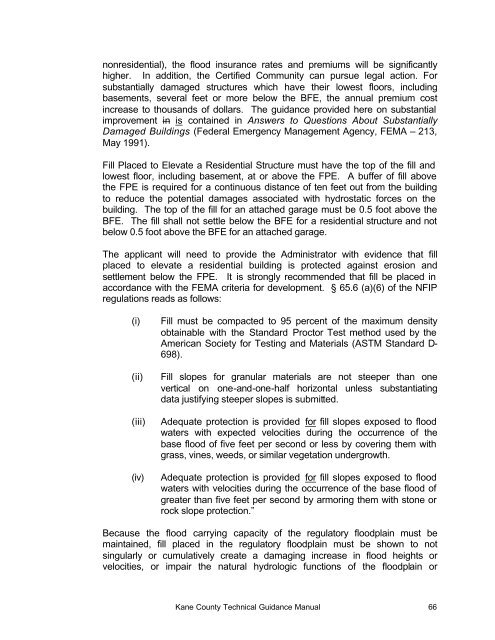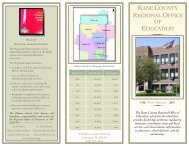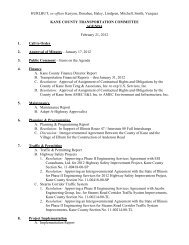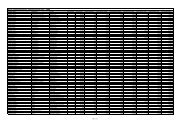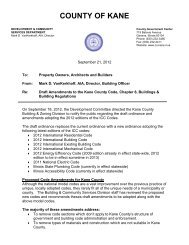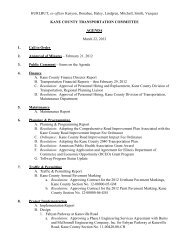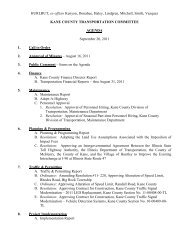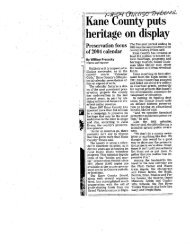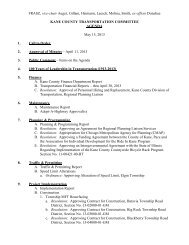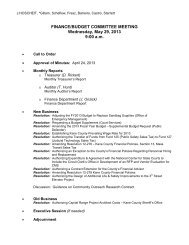kane county stormwater technical guidance manual - Kane County, IL
kane county stormwater technical guidance manual - Kane County, IL
kane county stormwater technical guidance manual - Kane County, IL
You also want an ePaper? Increase the reach of your titles
YUMPU automatically turns print PDFs into web optimized ePapers that Google loves.
nonresidential), the flood insurance rates and premiums will be significantly<br />
higher. In addition, the Certified Community can pursue legal action. For<br />
substantially damaged structures which have their lowest floors, including<br />
basements, several feet or more below the BFE, the annual premium cost<br />
increase to thousands of dollars. The <strong>guidance</strong> provided here on substantial<br />
improvement in is contained in Answers to Questions About Substantially<br />
Damaged Buildings (Federal Emergency Management Agency, FEMA – 213,<br />
May 1991).<br />
Fill Placed to Elevate a Residential Structure must have the top of the fill and<br />
lowest floor, including basement, at or above the FPE. A buffer of fill above<br />
the FPE is required for a continuous distance of ten feet out from the building<br />
to reduce the potential damages associated with hydrostatic forces on the<br />
building. The top of the fill for an attached garage must be 0.5 foot above the<br />
BFE. The fill shall not settle below the BFE for a residential structure and not<br />
below 0.5 foot above the BFE for an attached garage.<br />
The applicant will need to provide the Administrator with evidence that fill<br />
placed to elevate a residential building is protected against erosion and<br />
settlement below the FPE. It is strongly recommended that fill be placed in<br />
accordance with the FEMA criteria for development. § 65.6 (a)(6) of the NFIP<br />
regulations reads as follows:<br />
(i) Fill must be compacted to 95 percent of the maximum density<br />
obtainable with the Standard Proctor Test method used by the<br />
American Society for Testing and Materials (ASTM Standard D-<br />
698).<br />
(ii) Fill slopes for granular materials are not steeper than one<br />
vertical on one-and-one-half horizontal unless substantiating<br />
data justifying steeper slopes is submitted.<br />
(iii) Adequate protection is provided for fill slopes exposed to flood<br />
waters with expected velocities during the occurrence of the<br />
base flood of five feet per second or less by covering them with<br />
grass, vines, weeds, or similar vegetation undergrowth.<br />
(iv) Adequate protection is provided for fill slopes exposed to flood<br />
waters with velocities during the occurrence of the base flood of<br />
greater than five feet per second by armoring them with stone or<br />
rock slope protection.”<br />
Because the flood carrying capacity of the regulatory floodplain must be<br />
maintained, fill placed in the regulatory floodplain must be shown to not<br />
singularly or cumulatively create a damaging increase in flood heights or<br />
velocities, or impair the natural hydrologic functions of the floodplain or<br />
<strong>Kane</strong> <strong>County</strong> Technical Guidance Manual 66


